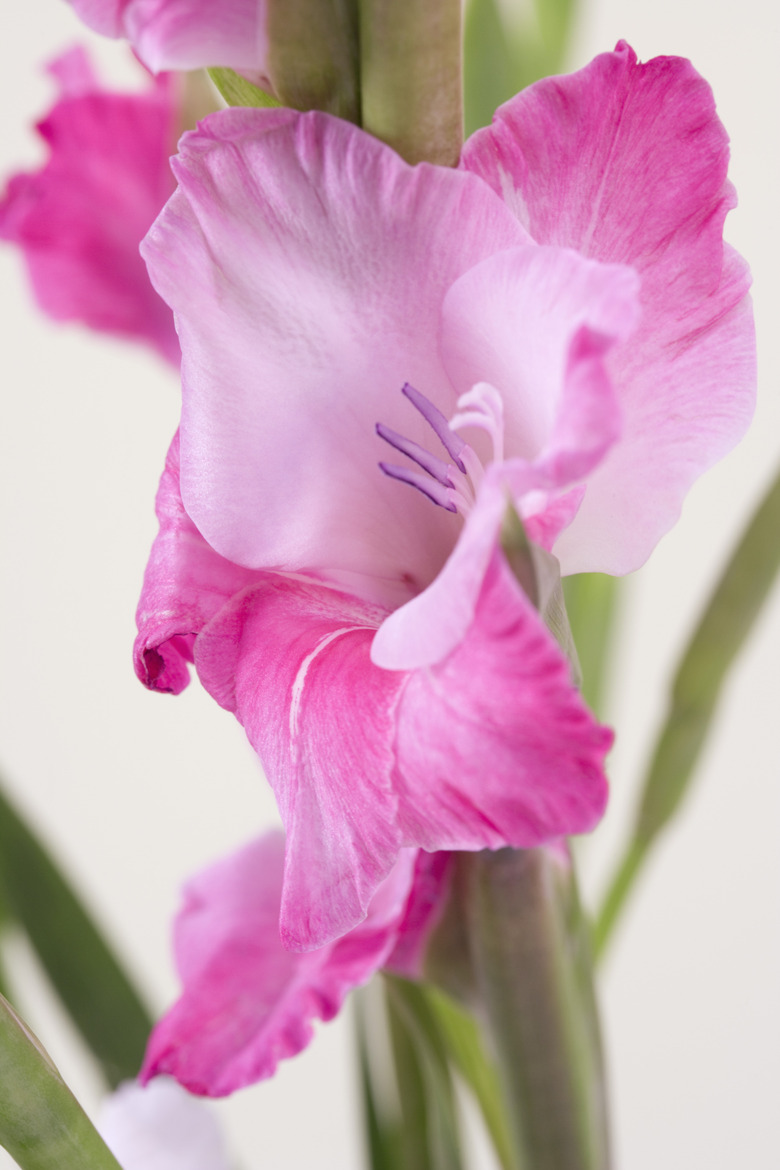How Long Does Gladiolus Last?
More than 10,000 named cultivars and approximately 250 species in the Galidiolus genus brighten landscapes in the wild and in gardens with their bright colors and pretty patterns.
More than 10,000 named cultivars and approximately 250 species in the Galidiolus genus brighten landscapes in the wild and in gardens with their bright colors and pretty patterns. Gladiolus grow from what are typically called "bulbs" but that which are actually corms — swollen underground stems that store nourishment for the plant. Glads, as they are commonly called, are both attractive and well known for being long-lasting as cut flowers in a vase.
Longer Lasting Cut Flowers
For a flower arrangement, cut the spikes of gladiolus florets in early morning or late evening when the stems are full of water and the temperature is cool. The bottom buds produce the first florets. Cut the spikes with sharp scissors after at least three of the bottom buds have opened; the rest of the florets will open in a few days. Leave at least four leaves on the plant. Fill a container with warm, preferably nonfluoridated water, trim any leaves that would fall below the waterline, and just before plunging the stems into warm water, trim the ends on a diagonal, which makes it easier for water to move up the stem.
- More than 10,000 named cultivars and approximately 250 species in the Galidiolus genus brighten landscapes in the wild and in gardens with their bright colors and pretty patterns.
- For a flower arrangement, cut the spikes of gladiolus florets in early morning or late evening when the stems are full of water and the temperature is cool.
Let the glads sit for two hours away from direct sunlight before you arrange them upright in a vase. Add warm water and a floral preservative to a vase, and once again trim the ends on a diagonal before immersing. Change their water daily, adding floral preservative and trimming 1 to 2 inches from the bottom of the stems. You should be rewarded with flowers for 10 to 14 days.
Protecting from the Cold
Gladiolus are perennials that are winter-hardy in U.S. Department of Agriculture plant hardiness zones 6 through 10. They can't survive soil that freezes deeply. If you live in an area with hard freezes, dig the corms up when the leaves begin to die back, about six to eight weeks after the plants bloom.
- Let the glads sit for two hours away from direct sunlight before you arrange them upright in a vase.
- If you live in an area with hard freezes, dig the corms up when the leaves begin to die back, about six to eight weeks after the plants bloom.
Longer Lasting Corms
Gladiolus corms are covered with overlapping, papery leaves called husks that form a point at the top. As the corms shrivel and die each year, they yield new corms with buds that will grow plants the next spring. If you separate new corms from the old to store for the winter, their bottoms should be firm, and they should not have dark spots or areas. Cut the stalks about 2 inches above the new corms, and then dip them in a fungicide. Keep the corms dry and store them indoors; a temperature of 40 degrees Fahrenheit is ideal.
Longer Blooming Garden
When the soil warms from from mid-April to mid-June plant the corms 3 to 4 times as deep as they are wide and 4 to 6 inches apart. Gladiolus plants bloom from 65 to 100 days after you plant them. To assure a succession of summer blooms, plant the corms every 10 to 14 days.
- Gladiolus corms are covered with overlapping, papery leaves called husks that form a point at the top.
- When the soil warms from from mid-April to mid-June plant the corms 3 to 4 times as deep as they are wide and 4 to 6 inches apart.
References
- Washington State University Extension: Gladiolus
- University of Missouri Extension: Summer Flowering Bulbs: Gladiolus
- Floridata: Gladiolus Spp.
- Old Farmer's Almanac: Gladiolus
- Purdue University: Gladiolus for Summer Flowers
- Birds and Blooms Magazine: Glads: Cutting and Care
- Pacific Bulb Society: Gladiolus
